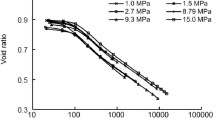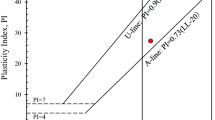Abstract
This experimental study investigates the effect of K0, anisotropic and isotropic consolidation stress paths on the undrained mechanical response of compacted high plasticity clay. This type of soils is being used for the construction of the core structure in the earthen embankment dams. Therefore, undrained soil properties in saturated state are essential to obtain for the stability analysis and design of certain conditions, such as rapid drawdown case. The actual consolidation system prevailing in the field is anisotropic in nature, and it is necessary to take that into account for the determination of strength and yielding criteria of the soil. However, this effect of the consolidation system has not been studied in detail for high plasticity clay in a compacted state. A series of consolidated undrained triaxial compression and extension tests were carried out on compacted high plasticity clay with different consolidation stress ratios (Kc = σh′/σv′ = 0.70 to 1.00) and stress history (OCR = 1 to 10). Results indicated that the normalized undrained shear strength reduced with anisotropic consolidation, and its relationship with consolidation stress ratio (Kc) was found linear at each OCR levels. The reduction in strength was observed highest for extension loading condition at normally consolidated state. Strain energy dissipation response displayed that the governing strain energy mechanism shifted from volumetric to shear strain energy, as consolidation state changed from anisotropic to isotropic. Based on the obtained yield surfaces, pre-failure shear behaviour of soil was found predominantly elastic for compression loading and elasto-plastic for extension loading conditions.














Similar content being viewed by others
Availability of data and materials
Some or all data generated or used during the study are available from the corresponding author by request.
Abbreviations
- A, B:
-
Skempton’s pore pressure parameters
- Ac,:
-
Skempton’s pore pressure parameter for compression shearing
- Ae :
-
Skempton’s pore pressure parameter for extension shearing
- Af :
-
Skempton’s pore pressure parameter at peak deviatoric stress
- CIUC:
-
Isotropically consolidated undrained compression
- CIUE:
-
Isotropically consolidated undrained extension
- CAUC:
-
Anisotropically consolidated undrained compression
- CAUE:
-
Anisotropically consolidated undrained extension
- Cc :
-
Compression index
- Cs :
-
Swelling index
- e:
-
Void ratio
- ei :
-
Initial void ratio
- ec :
-
Void ratio after consolidation
- Kc :
-
Horizontal to vertical stress ratio
- K0 :
-
Horizontal to vertical stress ratio at rest condition
- LSSV:
-
Length of stress vector
- OCR:
-
Over consolidation ratio
- p′:
-
Mean effective stress
- p′i :
-
Mean effective stress at the start of shearing
- q:
-
Shear stress
- qn :
-
Normalized shear stress
- Su :
-
Undrained shear strength
- Sun :
-
Normalized undrained shear strength
- W:
-
Dissipated strain energy
- WN :
-
Normalized dissipated strain energy
- εv, εa, εr :
-
Volumetric, axial and radial strain
- εvp :
-
Volumetric strain due to mean effective stress
- εvd :
-
Volumetric strain due to deviatoric stress
- εf :
-
Axial strain at peak deviatoric stress
- σ′v :
-
Effective vertical or axial stress
- σ′h :
-
Effective horizontal or radial stress
- σc :
-
Confining pressure
- σ′vc :
-
Pre-shear effective vertical consolidation stress
- σ′v (oc) :
-
Effective vertical stress at overconsolidated state
- σd :
-
Deviatoric stress
- σdn :
-
Normalized deviatoric stress
- (σdn)f :
-
Peak normalized deviatoric stress or undrained shear strength
- Δuw :
-
Excess pore pressure
- Δuwn :
-
Normalized excess pore pressure
- (Δuwn)f :
-
Normalized excess pore pressure at failure
- Λ0 :
-
Scaling exponent in SHANSEP equation
References
Abdulhadi NO, Germaine JT, Whittle AJ (2012) Stress-dependent behavior of saturated clay. Can Geotech J 49(8):907–916
Amorosi A, Rampello S (2007) An experimental investigation into the mechanical behaviour of a structured stiff clay. Géotechnique 57(2):153–166
Anandarajah A, Kuganenthira N, Zhao D (1996) Variation of fabric anisotropy of kaolinite in triaxial loading. J Geotech Eng 122(8):633–640
ASTM International (2011) Standard test method for consolidated undrained triaxial compression test for cohesive soils. ASTM D4767-11. ASTM, West Conshohocken, PA
ASTM International (2012) Standard test methods for laboratory compaction characteristics of soil using standard effort (12 400 ft-lbf/ft3 (600 kN-m/m3)). ASTM D698-12e2. ASTM, West Conshohocken, PA
ASTM International (2014) Standard test methods for specific gravity of soil solids by water pycnometer. ASTM D854-14. ASTM, West Conshohocken, PA
ASTM International (2017) Standard Practice for Classification of Soils for Engineering Purposes (Unified soil classification system). ASTM D2487-17e1. ASTM, West Conshohocken, PA
ASTM International (2017) Standard test methods for liquid limit, plastic limit, and plasticity index of soils. ASTM D4318-17e1. ASTM, West Conshohocken, PA
Bertrand F, Collin F (2017) Anisotropic modelling of opalinus clay behaviour: from triaxial tests to gallery excavation application. J Rock Mech Geotech Eng 9(3):435–448
Bozzano F, Bretschneider A, Martino S, Prestininzi A (2014) Time variations of the K0 coefficient in overconsolidated clays due to morphological evolution of slopes. Eng Geol 169:69–79
Cai Y, Hao B, Gu C, Wang J, Pan L (2018) Effect of anisotropic consolidation stress paths on the undrained shear behavior of reconstituted Wenzhou clay. Eng Geol 242:23–33
Casagrande A, Carillo N (1944) Shear failure of anisotropic materials. J Boston Soc Civil Eng 31:74–87
Casey B, Germaine JT (2013) Stress dependence of shear strength in fine-grained soils and correlations with liquid limit. J Geotech Geoenviron Eng 139(10):1709–1717
Chen YN, Yang ZX (2017) A family of improved yield surfaces and their application in modeling of isotropically over-consolidated clays. Comput Geotech 90:133–143
Cola S, Cortellazzo G (2005) The shear strength behavior of two peaty soils. Geotech Geol Eng 23(6):679–695
Davis EH, Christian JT (1970) Bearing capacity of anisotropic cohesive soil. J Soil Mech Found Div 97(5):753–769
Donaghe RT, Townsend FC (1978) Effects of anisotropic versus isotropic consolidation in consolidated-undrained triaxial compression tests of cohesive soils. Geotech Test J 1(4):173–189
Duncan JM, Seed RB (1986) Compaction-induced earth pressures under K0-conditions. J Geotech Eng 112(1):1–22
Gao YB (2013) Compression and extension yield of an anisotropically consolidated soil. Soils Found 53(3):431–442
Graham J, Noonan ML, Lew KV (1983) Yield states and stress–strain relationships in a natural plastic clay. Can Geotech J 20(3):502–516
Hicher PY, Wahyudi H, Tessier D (2000) Microstructural analysis of inherent and induced anisotropy in clay. Mech Cohes Frict Mater Int J Exp Model Comput Mater Struct 5(5):341–371
Hwang J, Dewoolkar M, Ko HY (2002) Stability analysis of two-dimensional excavated slopes considering strength anisotropy. Can Geotech J 39(5):1026–1038
Inci G, Yesiller N, Kagawa T (2003) Experimental investigation of dynamic response of compacted clayey soils. Geotech Test J 26(2):125–141
Kamei T, Nakase A (1989) Undrained shear strength anisotropy of K0-overconsolidated cohesive soils. Soils Found 29(3):145–151
Kuganenthira N, Zhao D, Anandarajah A (1996) Measurement of fabric anisotropy in triaxial shearing. Geotechnique 46(4):657–670
Ladd CC, Foott R (1974) New design procedure for stability of soft clays. J Geotech Eng ASCE 100(GT7):763–786
Lade PV (2016) Triaxial testing of soils. Wiley-Blackwell, Hoboken, ISBN: 978-1-119-10662-3
Lade PV, Wang Q (2012) Method for uniform strain extension tests on sand. Geotech Test J 35(4):607–617
Law KT, Holtz RD (1978) A note on Skempton’s A parameter with rotation of principal stresses. Géotechnique 28(1):57–64
Lee KL, Morrison RA (1970) Strength of anisotropically consolidated compacted clay. J Soil Mech Found 96(SM6):2025–2043
Lo KY (1966) Stability of slopes in anisotropic soils. J Soil Mech Found Div 91(a):85–106
Meng GH, Chu J (2011) Shear strength properties of a residual soil in Singapore. Soils Found 51(4):565–573
Mitachi T, Kitago S (1976) Change in undrained shear strength characteristics of saturated remolded clay due to swelling. Soils Found 16(1):45–58
Monroy R, Zdravkovic L, Ridley A (2009) Evolution of microstructure in compacted London Clay during wetting and loading. Géotechnique 60(2):105–119
Noorany I, Scheyhing C (2015) Lateral extension of compacted-fill slopes in expansive soils. J Geotech Geoenviron Eng 141(1):04014083
Nwabuokei SO, Lovell CW (1986) Compressibility and settlement of compacted fills. In: Yong R-N, Townsend FC (eds) Proceedings of the consolidation of soils: testing and evaluation. ASTM, West Conshohocken, PA, pp 184–202
Prashant A, Penumadu D (2005) Effect of overconsolidation and anisotropy of kaolin clay using true triaxial testing. Soils Found 45(3):71–82
Rowshanzamir MA, Askari AM (2010) An investigation on the strength anisotropy of compacted clays. Appl Clay Sci 50(4):520–524
Sachan A, Penumadu D (2007) Effect of microfabric on shear behavior of kaolin clay. J Geotech Geoenviron Eng 133(3):306–318
Sexton BG, McCabe BA, Karstunen M, Sivasithamparam N (2016) Stone column settlement performance in structured anisotropic clays: the influence of creep. J Rock Mech Geotech Eng 8(5):672–688
Shi J, Qian S, Zeng LL, Bian X (2015) Influence of anisotropic consolidation stress paths on compression behaviour of reconstituted Wenzhou clay. Géotech Lett 5(4):275–280
Sivakumar V, Doran IG, Graham J (2002) Particle orientation and its influence on the mechanical behaviour of isotropically consolidated reconstituted clay. Eng Geol 66(3–4):197–209
Skempton AW (1954) The pore-pressure coefficients A and B. Geotechnique 4(4):143–147
Tavenas F, Des Rosiers JP, Leroueil S, La Rochelle P, Roy M (1979) The use of strain energy as a yield and creep criterion for lightly overconsolidated clays. Geotechnique 29(3):285–303
Toyota H, Nakamura K, Sakai N (2003) Application of the elastic boundary induced by shear history on saturated cohesive soil. Soils Found 43(1):93–100
Toyota H, Sakai N, Nakamura K (2001) Mechanical properties of saturated cohesive soil with shear history under three dimensional stress conditions. Soils Found 41(6):97–110
Toyota H, Susami A, Takada S (2014) Anisotropy of undrained shear strength induced by K0 consolidation and swelling in cohesive soils. Int J Geomech 14(4):04014019
VandenBerge DR, Brandon TL, Duncan JM (2014) Triaxial tests on compacted clays for consolidated-undrained conditions. Geotech Test J 37(4):705–716
VandenBerge DR, Duncan JM, Brandon TL (2015) Undrained strength of compacted clay under principal stress reorientation. J Geotech Geoenviron Eng 141(8):04015035
Wang LZ, Shen KL, Ye SH (2008) Undrained shear strength of K0 consolidated soft soils. Int J Geomech 8(2):105–113
Wild KM, Amann F (2018) Experimental study of the hydro-mechanical response of Opalinus Clay-Part 2: influence of the stress path on the pore pressure response. Eng Geol 237:92–101
Yamamuro JA, Lade PV (1995) Strain localization in extension tests on granular materials. J Eng Mech 121(7):828–836
Yamamuro JA, Liu Y, Lade PV (2012) Performance and suitability of radial drainage materials in axisymmetric testing of clayey soils at high confining pressures. Geotech Test J 35(6):901–910
Acknowledgements
Financial support from IIT Gandhinagar is gratefully acknowledged. Any opinions, findings, and conclusions or recommendations expressed in this material are those of authors and do not necessarily reflect the views of IIT Gandhinagar.
Funding
Funding for the current research was provided from the research grants of IIT Gandhinagar.
Author information
Authors and Affiliations
Corresponding author
Ethics declarations
Conflict of interest
Not applicable.
Additional information
Publisher's Note
Springer Nature remains neutral with regard to jurisdictional claims in published maps and institutional affiliations.
Rights and permissions
About this article
Cite this article
Kantesaria, N., Sachan, A. Strain Energy, Yielding and Undrained Shear Characteristics of High Plasticity Compacted Clay Subjected to Stress Anisotropy. Geotech Geol Eng 40, 213–236 (2022). https://doi.org/10.1007/s10706-021-01897-7
Received:
Accepted:
Published:
Issue Date:
DOI: https://doi.org/10.1007/s10706-021-01897-7




